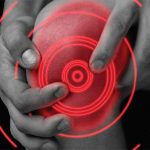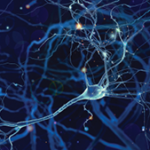In a first-of-its-kind program, the National Institutes of Health (NIH) and the University of Michigan Medical School hosted a conference that brought together internationally recognized pain and rheumatology experts. The two-day program, held on the NIH campus in Bethesda, Md., on December 14-15, 2010, included sessions on the basic science of pain, advances in pain science, government perspectives on pain, improving the pain care of patients, and the special considerations required for patients in special populations. The program was also supported by the ACR. Some highlights of the program, “Pain and Musculoskeletal Disorders: Translating Scientific Advances Into Practice,” are presented here.
Clinical Research into Central Pain Mechanisms in Osteoarthritis
“The definitive treatment for knee osteoarthritis (OA) is total or partial knee replacement. But pain persists in 20% to 30% of patients after surgery. Why?” asked Tuhina Neogi, MD, PhD, associate professor of medicine at the Boston University School of Medicine.
Dr. Neogi explained research into characteristics of advanced OA knee pain, notably the fact that it often occurs at rest or during the night, and that it radiates. “All of these are signs of altered signal processing,” she says. Mechanical and inflammatory stimuli that are characteristic of knee OA pathology can cause neurochemical alterations in the nervous system and alter peripheral and central processing. The result may be central sensitization, which can lead to heightened pain sensitivity. “We wondered if central sensitization could explain pain and persistence in OA,” says Dr. Neogi.
“Mechanical and inflammatory stimuli lead neurons to respond to stimuli in a more intense way or to stimuli they don’t ordinarily respond to,” she says. “Initially, the volume is still modifiable. Eventually, as the theory goes, it’s changed permanently. We want to know if it is modifiable—or is it stuck at this level?”
Compared with men, women are at greater risk for pain undertreatment. “Maybe it’s because women express pain more. When a man finally says something about pain, he’s taken more seriously. On the other hand, a woman’s psychological complaints are taken more seriously than men’s.”
Armed with data from small studies suggesting that central sensitization does occur in OA, Dr. Neogi and colleagues used data from an ongoing multicenter cohort study of 3,000 older adults (aged 50 to 79 years) who had OA or were at high risk for it. Each participant received a comprehensive functional knee assessment as well as radiographs and MRI studies. Central sensitization was specifically assessed by temporal summation. Using a within-person matched-knee approach that they had developed in the course of an earlier study, the team looked at people with evidence of central sensitization in one knee but not the other and determined whether OA accounted for the difference between knees.
“We found that the presence of OA doubled the risk of central sensitization, and as the severity of OA increased, so did the chance of central sensitization,” says Dr. Neogi. She adds that the data also suggested that the longer the duration of OA, the greater the risk of central sensitization.
Dr. Neogi also found that if central sensitization is present in a person who has had total knee replacement (TKR), the risk of pain in the replaced knee is twice what it would be in a person without central sensitization and that these patients were 67% less likely to experience pain improvement. Dr. Neogi notes that in future research, it will be important to determine if central sensitization can be used to predict TKR outcome and to determine if it is possible to time TKR so that central sensitization changes are not yet permanent. Dr. Neogi believes that people are probably not at equal risk, and that genetics or other factors may modulate this risk. Research conducted during the next three to five years may hold the answers to some of these questions.
What to do in the meantime? “We don’t have an effective treatment that alters progression of OA,” she says, adding that additional research may determine if there’s any potential benefit of knee bracing or orthotics. Physical therapy for musculoskeletal and gait issues are important, she says, adding that nonpharmacologic approaches are cost effective but underused. She urged more attention to sleep, mood, and coping issues in these patients.
Weight loss is also critical. “Without it, anything you try will be less effective,” she concludes.
The Hidden Dangers of Opioids: Opioid-Induced Hyperalgesia
Imagine how difficult it would be to take seriously a colleague’s report that the more sugar he added to his coffee, the more bitter it tasted. That’s the challenge potentially faced by pain specialists who introduce the concept of opioid-induced hyperalgesia to a patient with chronic pain problems, as described at the conference by Jianren Mao, MD, PhD, director of the Massachusetts General Hospital Center for Translational Pain Research and associate professor at Harvard Medical School in Boston.
Dr. Mao’s recent research explores the paradoxical phenomenon of opioid-induced hyperalgesia. Unlike tolerance, hyperalgesia is characterized by an increase in pain perception that seems to be worsened, not improved, by dosage escalation.1
“No one can say for sure, but there have been clinical reports of people whose pain is exacerbated at higher opioid doses. When the dose is reduced, they feel better,” he says.
The underlying mechanism by which this occurs is still unclear, says Dr. Mao, but he and other researchers are shedding light on the problem. “It could be the result of the opioid facilitating nociceptive transmission. The net outcome is to make the system more responsive to painful stimulation,” he says.
“Clinically, we must differentiate normal pain from opioid-induced hyperalgesia, because management is different,” continues Dr. Mao. Several clues in the patient report of pain may be red flags to the presence of hyperalgesia. The most prominent one, of course, is the observation that pain reduction is not achieved with dose escalation. Worse, the pain score may increase in the presence of higher doses of opioids.
Be open-minded about what opioids can and cannot do. Opioids need to be part of a larger overall strategy for pain management —not the sole analgesic solution.
“And when the patient has preexisting pain, it may change its location or quality, becoming diffuse, nagging, and hard to describe. Two types of pain—the preexisting one and the one related to hyperalgesia—may be superimposed on one another. It’s not a simple exacerbation of preexisting pain,” says Dr. Mao. “We believe that the cellular mechanisms mediating hyperalgesia are similar to those that mediate neuropathic pain,” he says, adding that the N-methyl-D-aspartate (NMDA) receptor is likely involved.
According to Dr. Mao, quantitative sensory testing can also be used to determine whether hyperalgesia is occurring. Agents like ketamine that block the NMDA receptor may affect the hyperalgesic response, at least temporarily. “We need solid clinical trials to verify that these clinical findings can be corroborated with ketamine-type experiments,” said Dr. Mao, who also notes that hyperalgesia can coexist with tolerance and addictive behaviors.
What is Dr. Mao’s advice to clinicians who manage patients with chronic pain who may be experiencing hyperalgesia? “Be open-minded about what opioids can and cannot do. Opioids need to be part of a larger overall strategy for pain management—not the sole analgesic solution,” he said.
Pain as a Women’s Health Problem
A review of research to date on the interaction between gender and pain experiences proves one thing: it’s complicated. Epidemiologic studies have confirmed that, compared with men, women are at increased risk for of chronic musculoskeletal pain disorders at any site, widespread pain and fibromyalgia, OA, RA, headache/migraine, and temporomandibular disorders.2-4
“We have explored different possible biologic and social factors that could account for these epidemiologic findings, including sex differences in nociceptive processing, differences in cognitive and affective variables, and gender roles and expectations,” says Lesley M. Arnold, MD, professor of psychiatry and director of the Women’s Health Research Center at the University of Cincinnati.
Experimental pain studies in humans have shown that women display greater sensitivity to pressure, electrical, thermal, and intramuscular injections of irritating solutions, Dr. Arnold explains. A study that used positron emission tomography (PET) showed that when a heat stimulus was adjusted to elicit the same pain report in men and women, men showed an activation pattern that suggested sensory process dominance, while women showed activation suggesting affective integration of sensory input.5 “It’s not clear what this means, but maybe neuroimaging can help us understand sex differences in pain responses,” says Dr. Arnold.
“The next big area is the influence of hormonal factors. What’s happening in girls to increase the prevalence of migraine, temporomandibular disorders, and other pain conditions at puberty?” she asks. Data collected to date suggest that fluctuating estrogen levels during the menstrual cycle may intensify musculoskeletal pain and migraine symptoms.
“We also think that the peripheral and central effects of estrogen may be divergent and that estrogens can have pro- and antiinflammatory effects. Estrogen may also affect the endogenous opiate system,” says Dr. Arnold. “The bottom line is that a role for estrogen is suggested, but it’s a complicated one and still under study.”
Mechanisms for pain coping also differ in men and women, according to Dr. Arnold, with women generally being at greater risk for internal catastrophizing, or “focusing on overwhelming, negative aspects,” in response to pain, she explains. Catastrophizing contributes to the pain experience and may account for sex differences in diffuse noxious inhibitory controls (DNIC). Dr. Arnold says that men show greater DNIC, a descending pathway that modulates pain inputs to the brain, than women do. Further, sex differences in DNIC are not significant after catastrophizing has been controlled for.6,7
Not surprisingly, investigators in this field have also explored how gender roles and expectations influence pain perceptions. The male norm is marked by increased pain tolerance, the female norm by acceptance of pain as a normal part of life, with more leeway for expression about it. When individuals are evaluated for “masculinity” and “femininity,” explains Dr. Arnold, greater femininity predicts more intense experimentally induced pain.4
Compared with men, women are at greater risk for pain undertreatment. “Maybe it’s because women express pain more. When a man finally says something about pain, he’s taken more seriously,” she says. “On the other hand, a woman’s psychological complaints are taken more seriously than men’s.”
In coming years, Dr. Arnold hopes that clinicians can be educated to think about chronic pain as a disease process. She adds that one goal might be to find ways to accurately assess DNIC in a busy clinic. She also urges her colleagues to take advantage of a multidisciplinary approach to pain management and to individualize treatment.
Studying Pain in Children
At the start of her presentation on pain in children, Laura E. Schanberg, MD, professor of pediatrics at Duke University School of Medicine in Durham, N.C., reminded her audience that prior to the 1990s, infants and young children received minimal anesthesia and little or no postoperative pain management. As recently as 1986, half of pediatricians, surgeons, and family practitioners assumed that infants did not experience pain in the first month of life.8
As described by Dr. Schanberg, the consequences of acute pain during childhood may include changes in future pain processing, fear and avoidance of healthcare, reduced effectiveness of analgesics later, reduced procedural effectiveness, and distress for parents and healthcare providers. Preterm infants, who receive repeated noxious stimulation show increased stress responses to subsequent procedures and higher somatization scores and increased thermal pain sensitivity as adolescents. Circumcised infants show stronger pain responses during routine vaccinations, and young children exposed to repeated painful procedures experience more pain and anxiety as they undergo more procedures.9-11 The problem is not limited to infants and small children. The Danish Prospective Study, which included 650 children, showed that low back pain in children at age 14 years predicted low back pain, disability, and hospitalization 25 years later.12
Pain research is challenging in any patient population, says Dr. Schanberg, but the pediatric realm presents some unique problems. These include devising an age-appropriate pain assessment and accounting for the changes caused by growth, the onset of puberty, and numerous immunologic, neurologic, and psychosocial variables. The ethics of research are more complex in children because of the need to protect a vulnerable patient population. “Pain may also have a strong genetic component in children, too,” she says.
“We’ve learned that children’s pain is more plastic than that of adults,” says Dr. Schanberg. “This means that environmental and psychological factors may exert a more powerful influence on pain perception than in adults.” Citing some of her own research, Dr. Schanberg describes how negative mood and stress increased daily symptoms of pain, fatigue, and stiffness in children with juvenile idiopathic arthritis (JIA). “It’s interesting that in adults with chronic pain, stress and mood predict pain tomorrow and the next day, but in children they only predict pain today, possibly because children live more in the moment,” she speculates. Parent stress also predicts child pain and depression, she says. “Children do better when parents respond to their pain sympathetically than children whose parents do things that help them avoid their own distress,” she notes. “If parents catastrophize about their child’s pain, they tend to restrict activities to reduce their own distress. That tends to increase the child’s disability.”
Dr. Schanberg offers this take-home message for people who treat pain in children: “Pain starts early. Pain experiences in very young children impact the way their pain processing system is put together and may continue to affect pain perception when they are adults.”
Mary Desmond Pinkowish is a medical journalist based in New York.
References
- Colvin LA, Fallon MT. Opioid-induced hyperalgesia: A clinical challenge. Br J Anesth. 2010;104:125-127.
- Unruh AM. Gender variations in clinical pain experience. Pain. 1996;65:123-167.
- Greenspan JD, Craft RM, LeResche L, et al. Studying sex and gender differences in pain and analgesia: A consensus report. Pain. 2007;S26-S45.
- Fillingim RB, King CD, Ribeiro-Dasilva MC, et al. Sex, gender, and pain: A review of recent clinical and experimental findings. J Pain. 2009;10:447-485.
- Derbyshire SW Nichols TE, Firestone L, et al. Gender differences in patterns of cerebral activation during equal experience of painful laser stimulation. J Pain. 2002;3:401-411.
- Goodin BR, McGuire L, Allshouse M, et al. Associations between catastrophizing and endogenous pain-inhibitory processes: Sex differences. J Pain. 2009;10:180-190.
- Weissman-Fogel I, Sprecher E, Pud D, et al. Effects of catastrophizing on pain perception and pain modulation. Exp Brain Res. 2008;186:79-85.
- Schecter NL, Allen DA. Physicians’ attitudes towards pain in children. J Dev Behav Pediatr. 1986; 7:350-354.
- Grunau RE, Oberlander TF, Whitfield MF, et al. Demographic and therapeutic determinants of pain reactivity in very low birth weight neonates at 32 weeks’ postconceptional age. Pediatrics. 2001; 107:105-112.
- Buskila D, Neumann L, Zmorra E, et al. Pain sensitivity in prematurely born adolescents. Arch Pediatr Adolesc Med. 2003;57:1079-1082.
- Hermann C, Hohmeister J, Demirakça S, et al. Long-term alteration of pain sensitivity in school-aged children with early pain experiences. Pain. 2006;125(3):278-285.
- Harreby M, Neergaard K, Hesselsøe G. Are radiologic changes in the thoracic and lumbar spine of adolescents risk factors for low back pain in adults? A 25-year prospective cohort study of 640 school children. Spine. 1995;20:2298-2302.



